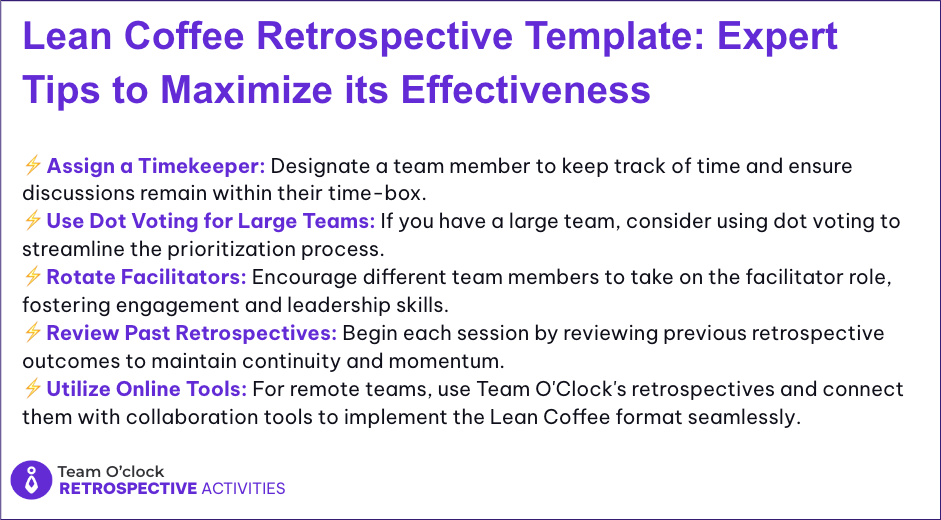
What You Need to Know About the "Lean Coffee" Retrospective Template

Even Agile teams often struggle to run productive retrospective meetings. Unstructured discussions can lead to scattered ideas, missed opportunities, and misaligned priorities. Traditional, agenda-heavy meetings sometimes fail to capture the full spectrum of team input, limiting flexibility and stifling dialogue. For many Agile teams, this is a significant pain point.
But what if there was a simple, adaptable way to foster open collaboration and streamline retrospective meetings? Introducing the Lean Coffee Retrospective Template, a method developed in 2009 by Jim Benson and Jeremy Lightsmith in Seattle. This framework allows teams to decide on discussion topics collaboratively, ensuring time-efficient, engaging conversations that drive continuous improvement.
Let's dive deeper into the Lean Coffee retrospective template and how it can facilitate your Agile meetings.
What is the Lean Coffee Retrospective Template?
The Lean Coffee Retrospective Template was born from a necessity to create a more flexible and democratic meeting format. In 2009, Jim Benson and Jeremy Lightsmith introduced the Lean Coffee framework to facilitate discussions without a predetermined agenda. The goal was to allow participants to propose topics that matter to them, vote on the most relevant ones, and engage in structured conversations driven by the group's priorities.
This method ensures that all voices are heard, which is especially critical for Agile teams that rely on continuous improvement through collaborative retrospectives. Unlike traditional agenda-driven meetings, the Lean Coffee retrospective template promotes a more engaging, dynamic, and inclusive process orchestrated by all members.
How it Works
The Lean Coffee retrospective template is straightforward and adaptable, which is why it has gained popularity within Agile teams. Here's how it works:
Topic Suggestion: At the beginning of the meeting, each participant is invited to suggest topics or issues they want to discuss. These topics are placed on a board, either physical or digital.
Voting: Once all topics are listed, the team votes on which topics they find most relevant or essential. Each person may have a set number of votes (e.g., two votes per person).
Time-boxed Discussions: The topics with the most votes are discussed first. Each discussion is time-boxed to ensure the conversation stays focused. Once the time is up, the group decides whether to continue the discussion or move on to the next topic.
Iteration: If the team feels a topic requires more discussion, they can vote to extend the time. If not, they move to the next item on the list.
This iterative process ensures that the retrospective stays focused and productive while prioritizing the topics that matter most to the team.
What Are The Benefits?
The Lean Coffee retrospective template offers several benefits, making it ideal for Agile teams:
Prioritized Discussions: The team only discusses the most pressing issues, ensuring time isn't wasted on low-priority topics.
Democratic Process: Everyone has the opportunity to contribute, ensuring that the discussions are shaped by collective input.
Adaptability: The format works for both in-person and virtual meetings, making it versatile for any team setup.
Time Efficiency: The time-boxed approach helps keep the retrospective concise and focused.
Collaboration: The method fosters an open, collaborative environment where continuous improvement is emphasized.
Problem Prevention and Resolution: Lean Coffee often illuminates important topics that might not have been addressed in a traditional retrospective format.
How to Implement the Lean Coffee Retrospective Template
The popularity of the Lean Coffee retrospective template lies in its simplicity. Here's a step-by-step guide on how to implement it in your next retrospective.
Before the Meeting:
Set up a virtual or physical board where participants can suggest topics.
Prepare a voting system for topic prioritization, such as raising hands or digital voting tools.
During the Meeting:
Facilitate a brainstorming session where participants write down their thoughts or issues on sticky notes or virtual cards.
Allow the group to vote on which topics are the most important to them.
Once voting is complete, start discussing the highest-priority topics, time-boxing each discussion.
Monitor the time and allow the team to vote on extending the discussion for a specific topic or moving on if necessary.
After the Meeting:
Gather feedback from participants on the effectiveness of the retrospective.
Follow up on any action items or decisions made during the meeting to ensure continuous improvement.
What Are the Challenges in Implementing the Lean Coffee Retrospective?
While the Lean Coffee retrospective template is simple, it's important to be mindful of potential challenges such as:
Unbalanced Participation: Some participants may dominate the conversation. Facilitators should encourage quieter team members to share their thoughts.
Time Management: Without strict time-boxing, discussions can drift off course, reducing the meeting's overall effectiveness.
Overemphasis on Voting: While voting is important, teams should avoid getting bogged down in the process. The goal is to spark meaningful discussions, not to spend excessive time on voting.
Expert Tips to Maximize its Effectiveness

Takeaway
The Lean Coffee retrospective template is a versatile, democratic tool that helps Agile teams run more effective, structured, and engaging meetings. This format emphasizes flexibility and collaboration, allowing the team to prioritize discussions based on collective input rather than rigid agendas.
By embracing the Lean Coffee retrospective template, your Agile team can foster a culture of continuous improvement, leading to more productive conversations and actionable insights. Whether your team is in-person or distributed, this format adapts easily to any environment and can significantly enhance the quality of your retrospectives.
If you're looking to unlock more productive and engaging retrospective meetings, try the Lean Coffee Retrospective Template by Team O'Clock. Start today and enjoy our 15-day free trial to see how this framework can facilitate your next retrospective.








